Dead Air Silencers released their first dedicated .223/5.56 suppressor, the Sierra-5, at the NRA show this weekend. It’s a compact, heavy-duty silencer designed specifically for 5.56 use without barrel length restrictions.
Available with either a Dead Air Xeno or KeyMo mount included, the Sierra-5 is threaded with the “industry standard” 1.375×24 mount pitch so the sky’s the limit for choosing and using your favorite mounting system
I like the checkering on the body. It looks cool, it provides grip for mounting and removing the suppressor, and it also aids heat dissipation by increasing surface area.
Though the Sierra-5 is compatible with the same front caps as Dead Air’s Sandman series, don’t mistake it for a Sandman with a smaller bore. Dead Air says the baffle geometry is unique to the Sierra-5, because it’s uniquely designed for the pressure and gas flow characteristics of 5.56.
They say the tone of the Sierra-5 is really great, and it has a nice, big blast chamber with some venting features that cut down on gas blowback in AR platform guns. We’ll get our hands on one soon to see how she stacks up!
Click to enlarge these one-pager photos:

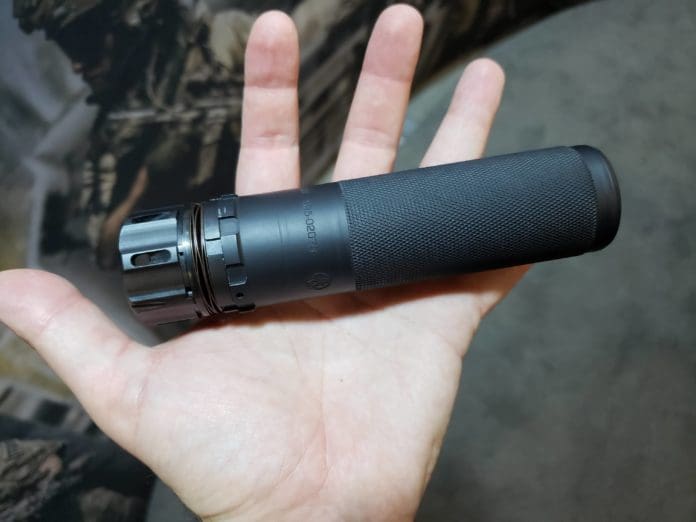

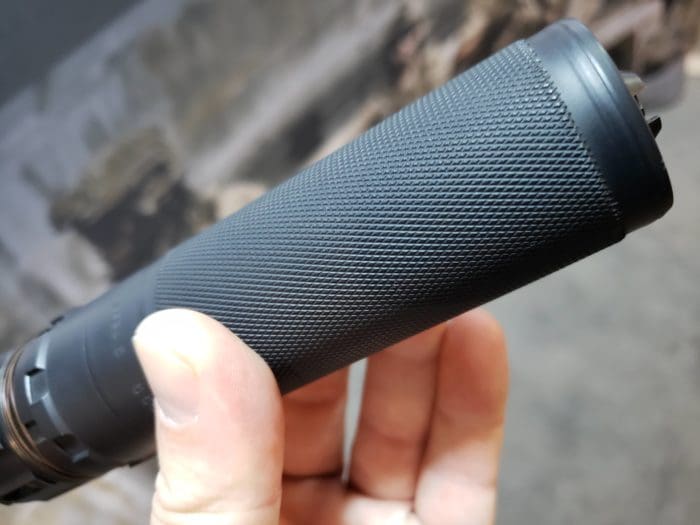
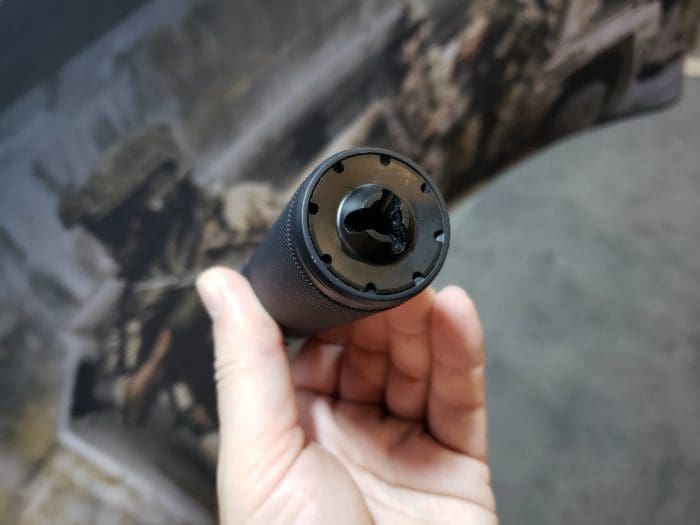
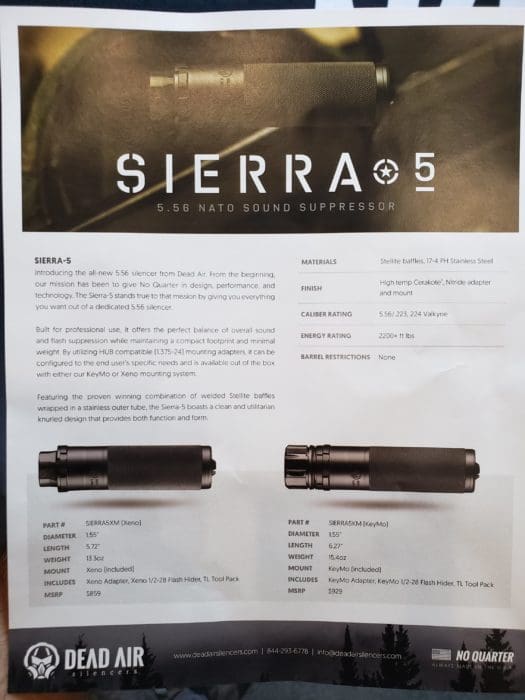
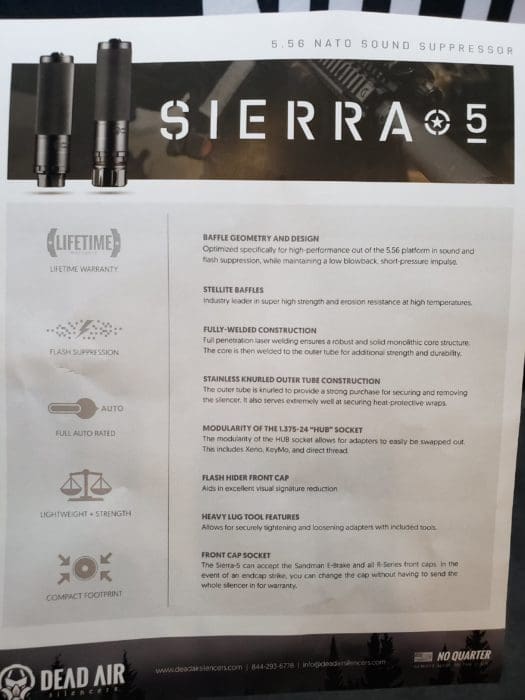



No snark, I wonder how things like this will sell with the potential for a new AWB in the mix.
Chris Jacobs (R-NY) seems to have have gone all-in on it but he’s in the House, so WGAF? The Senate might get interesting and come down to Manchin again.
Ultimately I think they fail to pass anything but jawbone a lot to try to rev up their base.
“No snark, I wonder how things like this will sell with the potential for a new AWB in the mix.”
The same as ’94, the existing ‘bad guns’ just shot up in value.
Add to that the impact of a positive SCotUS 2A decision that looks more than likely a result of ‘strict scrutiny’ squashing gun control, then who knows?
A whole lot of things are about to happen in a very short period of time, it seems to me.
On the can – It’s for a supersonic round, so nothing groundbreaking, right?
I was specifically wondering if people would use e-Form 4s to quickly acquire such a muffler or if they’d hold off to wait and see what happens with an AWB that might affect their ability to procure something to attach a silencer to.
I’m just curious if people take a “buy it now” approach or see such a thing as a liability until the threat of an AWB passes. A can like this would, honestly, make it a bit hard to argue that you’re putting it on a .223/5.56 bolt gun (though that’s possible to do) because why would you want one rated for short barrels and full auto?
As for the item in question specifically, Dead Air makes some good stuff. I’d assume it to be quite a nice can. They say it’s for “heavy projectiles” so it seems to me, from what’s available here, like this was kinda designed with SBRs launching heavier rounds with a faster twist.
Like, I dunno, a 62+gr with a shorty 1:7 or 1:8 barrel plus this thing. But at under 6″ it would work on a 16″ barrel too if you pick the right bullet for it.
Under normal circumstances I’d consider one but I don’t really need another 5.56 muffler at this point. I’d rather suppress my .243.
*heavier round with a slower twist. Faster twist overstablizes heavier rounds.
I always get that backwards when I say it. Apparently when I type it too.
Buying a suppressor or two makes sense at this point, but an AR pistol, not so much.
Not with the ATF getting ready to crap all over the better pistol braces. Yeah, they are very likely to lose in court, but that will take months or years and isn’t guaranteed. Sure you can buy a 16 inch bbl and put it on, but does that cover you legally if you bought it instead of built it? We really need to delete ATF.
I’m about 45 days into my first tax stamp wait.
The $200 rebate Rugged had back in March was too good to resist. The Obsidian 45 was around $200 below MSRP & in stock at Silencer Shops too. The kiosk made it a breeze, took around 10 minutes to do the entire process.
Got to shoot my can two weeks after purchase.
Now, if I could just take it past the door threshold of my FFL, that would be great.
The waiting is the hardest part.
Have you certified yet? The wait starts AFTER certification at your FFL. I’m on day 132 after certifying E-Form 4 trust on a Trash Panda. It looks as if Washington State is the slowest state in the nation and I’m in Washington State.
My purchase was on 3-30, my cert and tax stamp payment processed on 4-12. The can was received by my FFL that same day (4-12).
I could have shot the can on the cert day if I had brought one of the Suppressor hosts along to my FFL.
“I like the checkering on the body. It looks cool, it provides grip for mounting and removing the suppressor, and it also aids heat dissipation by increasing surface area.”
“… it also aids heat dissipation by increasing surface area…”
It (the checkering) causes (not aids all that much because this is so inefficient) heat dissipation by increasing surface-to-volume ratio, not surface area, for the heat energy moving across the surface similar to a heat sink ‘fin’ exposure to surrounding air for dissipation but not as efficient – the checkering causes a difference in the temperatures between the body (under the checkering) and its environment (the surrounding air) or in other words, by extension, what we call ‘heat dissipation’. Its the same original surface area as before the milling around the checkered area, just the surface-to-volume ratio has changed due to the checkering. Its a physics thing. No, ‘surface-to-volume ratio’ and ‘surface area’ are not the same thing.
An increase in surface area would mean adding metal. That’s not what happened here. The tube is milled down leaving a raised area that is then checkered. The checkering is removing metal down to the milled area level thus decreasing the amount of metal available for heat dissipation.
Using the dimensions of this suppressor, and applying Newton’s law of cooling… the heat dissipation would be much better by a factor of ~6 if a separate mechanically bonded very tight fitting sleeve, same wall thickness as the original tube, were placed over a tube that is smooth then that sleeve is checkered.
Clarification for …. “The checkering is removing metal down to the milled area level thus decreasing the amount of metal available for heat dissipation.”
decreasing the amount of metal (by the checkering) means a decrease in surface area, not an increase in surface area. Thus heat dissipation for this suppressor is not aided by the checkering “increasing surface area” because the checkering is actually decreasing metal surface area.
So you have a cylinder with a length of 2, radius of 1. Surface area is 6*pi.
1*pi (end) + 2 (length) * 2*pi (diameter) + 1*pi (end) = 6*pi
In the middle of it, you now cut a ring out of it, that is 1 long, to a depth of 1/2. Your new surface area is 6.5*pi.
1*pi (end) + 2*pi*1/2 (first large cylinder) + 1*pi-(1/2)^2*pi (washer shape 1) + 1*pi*1 (inner small cylinder) + 1*pi-(1/2)^2*pi (washer shape 1) + 1*pi (end) = 6.5 * pi
This shows that removing material (volume) does in fact increase surface area. The area you gain by deforming the surface negatively is always more than the area you lose on a non-deformed surface. Really it probably makes little to no difference but they are technically correct.
Should be:
1*pi (end) + 2*pi*1/2 (first large cylinder) + 1*pi-(1/2)^2*pi (washer shape 1) + 1*pi*1 (inner small cylinder) + 1*pi-(1/2)^2*pi (washer shape 1) + 2*pi*1/2 (second large cylinder) 1*pi (end) = 6.5 * pi
Forgot to represent the second larger cylinder in proof of work.
No, they aren’t technically correct for their heat dissipation claim.
“This shows that removing material (volume) does in fact increase surface area. The area you gain by deforming the surface negatively is always more than the area you lose on a non-deformed surface.”
Hmmmm…. not true.
If you have an object, and you remove some of that original object you will always have less of the original object that occupies the given original space – in other words less mass in the original object.
Heat transfer = (mass)(specific heat)(temperature change)
Q = mcΔT
Q = heat content in Joules
m = mass
c = specific heat, J/g °C
T = temperature
ΔT = change in temperature
Note the term “mass” – for heat dissipation mass is not volume or surface area. Volume is not the same as surface area or mass. You have taken two disparate units and attempted to combine them for a heat energy transfer event. Physics for energy, yes even heat is energy, doesn’t work the way you propose in your calculations. What you propose in your ‘calculations’ is impossible. You have magically added ‘mass’ where there is none by use of disparate units and something you call “volume” as basically equal to surface area. Then you throw in the term ‘depressed’ when the metal was not ‘depressed’, it was removed (milled away) meaning the same mass is no longer there as it originally was and removing that metal created areas that were lower than surrounding thus the checkerboard pattern.
Its got nothing to do with “washers” or “volume”.
Using the ‘Law of Conservation of Energy’ which apply here because heat is energy…
… surface-to-volume ratio is a tangential result of presence or absence of mass. It is not surface area and it is not volume separately (as you try to treat them in disparate units – and how and where washers enter into this, well, it doesn’t.) – but rather is basically the amount of surface area per unit volume of an object. Unit volume is the entire area of a unit of the material, not just the surface. In terms of heat energy transfer, when mass decreases surface-to-volume ratio decreases – when mass increases surface-to-volume ratio increases. Heat energy is transferred through the metal mass at a certain rate (depending on the metal type), not along the surface of the metal (as you presume without, I think, realizing it), metals have a heat transfer coefficient which defines this rate. When metal material is removed mass decreases and when mass decreases the ability to meaningfully dissipate energy across the mass decreases thus less dissipation of heat. If too much metal is removed the heat will to some extent eventually deform the metal because there is not enough mass to meaningfully dissipate the heat energy.
It is not true that the checkering “also aids heat dissipation by increasing surface area.”
Comments are closed.